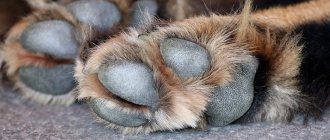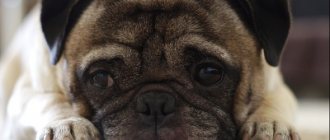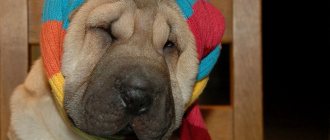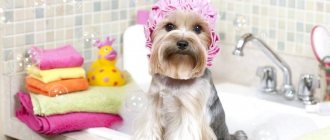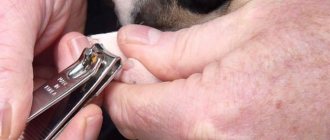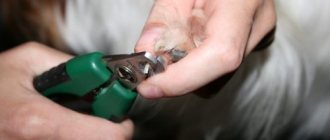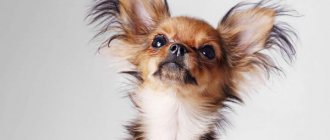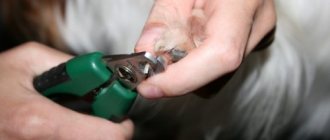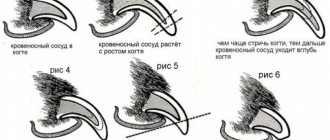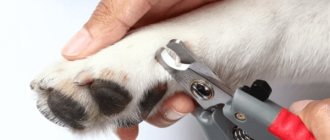- Firstly, overgrown claws prevent the animal from moving normally, prevent the correct placement of the paw, and cause a change in gait. For sports and show dogs, incorrect movements due to long nails, among other things, can lead to removal from the area or ring. In addition, if you step on the pad incompletely, additional stress is placed on the joints.
Secondly, excessively long claws bend and can grow into the paw pads. The animal feels severe pain, licks or chews the wound, as a result of which the paw becomes inflamed and lameness develops.
In addition, overgrown claws simply look ugly, and the dog gives the impression of being unkempt.
Nail trimming tools
To trim your Yorkshire Terrier's nails, you need to prepare everything you need in advance:
- The nail clipper is the main tool. It is sold in pet stores. It is better not to skimp on its quality, since it is purchased for many years.
- File - it is necessary to smooth out unevenness. It is convenient to use a non-traumatic glass file. You cannot use the same file to trim human nails and animal claws.
- A means to stop bleeding.
It is necessary to stop the bleeding when the “living part” of the claw is cut off and the vessel bleeds. This can be a hemostatic pencil or sponge, baking soda, corn starch, potassium permanganate. The pencil should be moistened with water and applied to the bleeding claw. A piece is cut off from the sponge and glued to the claw. These are the most convenient means to stop bleeding. If they are absent, the claw should be dipped in soda or starch for a couple of minutes until a lump forms. The lump will disintegrate on its own after the bleeding stops. Manganese must be used very carefully so as not to burn the dog. In general, this remedy is no longer popular due to the danger of poisoning.
If the owner does not know how to trim a Yorkie’s nails at home, he should contact a specialist in canine cosmetology – a groomer. The groomer will easily and quickly cope with the task and teach the dog’s owner to perform this simple manipulation.
Tips and warnings
Nail trimming is a very important procedure. If you do not take care of the nails, they will grow endlessly and cause inconvenience to both the dog and the owners.
Not every dog can grind its claws down during a walk - decorative breeds are most often found outside on a surface that is far from being where their claws are worn down naturally. Of course, overgrown nails are not only a problem for toy breeds; large or medium-sized dog breeds can also suffer from overly long nails.
Untimely nail trimming can cause your dog to:
- Violation of joint development;
- Cause irreversible changes in the position of the paw;
- Change in gait;
- Cause constant pain.
A gradually growing claw can grow inward, cause inflammation and infection of the wound, and this threatens the pet’s life. An ingrown claw is a very painful condition that can only be treated by a veterinarian through surgery to remove the ingrown claw.
Determining when to trim a dog’s nails is not difficult: as soon as the claws “clack” around the house, you need to take up the nail clipper.
If your dog is very nervous about the nail trimming procedure, panics and does not even allow you to pick up its paw, you should contact a veterinarian - at the veterinary clinic, the dog will be given a sedative and the nails will be trimmed quickly and accurately.
How much can you cut (video)
Praise and reward for patience
In addition to preparing the tools and the dog itself for the procedure, be sure to prepare a treat. This way the manipulation will be associated only with good impressions.
Even if the dog owner touched the vessel and the dog got scared, you should not let the animal go, but calm it down with a calm voice and strokes. When the dog calms down, praise him and give him a treat. No one is better able to carry out the procedures and calm the dog than the owner.
Each manipulation of an individual finger should be rewarded with praise and treats.
What will you need?
- Nail clipper , sold at any pet store, preferably “Guillotine” and always in NORMAL size. The idea that everything should be small for a small dog does not hold true in this case. Trying to cut the nails of a squirming Yorkshire terrier with a microscopic nail clipper will make you tired of it in exactly 3 seconds.
- Cotton buds
- Dry potassium permanganate , so that if something irreparable happens (ha-ha) and you touch the living part of the nail (oh-horror!), cauterize the vessel and the claw will not bleed.
What to do if you get a cut
To provide first aid, you need to have a first aid kit on hand filled with:
- bandages;
- cotton pads;
- special hemostatic powder or talc;
- Streptocide tablets or other antiseptic;
- gauze;
- healing ointment with an antiseptic effect.
Accidental damage to living tissue leads to severe bleeding and pain. The animal must be calmed and the wound site treated with powder.
Important! Attempting to use iodine or alcohol-containing solutions will cause a burn and increase the pain. Next time the animal will not let you approach him with a nail clipper.
Streptocide or liquid solutions (without alcohol) can be used as an antiseptic. The wound is cleaned with the drug and a bandage is applied. After a few hours, it is changed, and instead of an antiseptic, a healing ointment is used.
Important! If during the procedure the dog begins to tear from his hands and there is a tear in the tissue near the claws, then the wound is wrapped in gauze and ice is applied to the problem area. Immediately after completing first aid, the animal is taken to the veterinarian - it is impossible to cope with the consequences without his intervention
Now about how to trim “correct” and “incorrect” claws
“Irregular” claws should be cut either close to the living layer, or slightly gripping it, fig. 2 . Don't be afraid of slight bleeding, just cauterize the nail with dry potassium permanganate using a cotton swab. If you trim the claws in this way often enough, the living part will begin to shrink and gradually return to normal, Fig. 4
If the “wrong” claws are very long, you need to cut the nail to normal length without paying attention to the living part. Immediately burn each nail with potassium permanganate so that it does not bleed, fig. 3 It is often mentally difficult for owners to do this, and the first few times, until the living part becomes shorter, it is worth contacting a veterinarian or groomer. As in the previous case, the living part will return to normal over time, and cutting your nails will not cause any problems.
Normal Yorkshire Terrier nails are easy to trim and are absolutely painless for the dog. Using a nail cutter, cut off the tip of the claw, flush with the paw pad, at an angle of 45 degrees, Fig. 5 . If the nail is light-colored and the living part is visible in the light, the remaining nails are cut off in the same way. A Yorkshire Terrier needs to trim its nails 1-2 times a month . Don't forget to cut your fingernails too.
The nail is of normal length - short, does not reach the floor, the dog does not “click” its claws, Fig. 6
What to do if it doesn’t give in and bites
In this case, you can try the following. First, try to calm the dog down and distract it with treats. If you can’t cope on your own, you can ask your loved ones for help. One assistant holds the dog, and the second does the claws.
For each successfully trimmed nail, the pet is given treats.
Another option is this. The dog is wrapped in a towel. One person holds a pet, and the other cuts a haircut. If you still can’t cope, then you should contact a groomer. Groomers have more experience and will be able to solve the problem.
How to cut a Yorkshire Terrier's nails
In order to trim the nails of a Yorkshire Terrier correctly and fearlessly, you need to understand how this claw works. Figure 2 shows the structure of the “wrong” nail - the thin living part has grown along the entire length of the nail, the claw is very long and the paw pads reach the floor only with the back part, the dog’s center of gravity is shifted and the joints do not work correctly.
Yorkie claw structure
A dog's claws consist of several parts:
- The outside of the claw is hard;
- Inside there is a soft layer - pulp.
The pulp area contains a large number of thin blood vessels. As the claw grows, all layers increase simultaneously.
The first picture shows schematically the structure of a dog's claw:
B). Hard part (dead tissue).
The second picture shows what happens to the claw if it is not shortened for a long time. Without regular trimming, living tissue begins to fill the entire claw. Its length makes it difficult to step on the paw with all your weight. As a result, the center of gravity shifts, which leads to improper functioning of the joints.
The claw itself consists of two layers:
- Keratin coating;
- Nail bed area.
While there are no nerve endings in the keratin layer, there are many of them in the nail bed. In addition, at the base of the claw there are capillaries and blood vessels. You need to handle them very carefully. If you damage them, you can seriously harm your pet.
How to litter train a Yorkshire Terrier puppy.
Everyone knows that a baby Yorkshire terrier who has not been vaccinated cannot walk on the street, and he has to be toilet trained at home in a diaper or in a litter tray. All veterinarians and breeders constantly hear the question: “ How to toilet train a puppy?” ". There is nothing complicated about this, all you need is your patience and perseverance!
How to cut your Yorkie's hair yourself - step-by-step instructions
When purchasing a Yorkshire Terrier for a home, the future owner must be aware that the long, well-groomed coat requires complex, regular care. Finding a groomer who will tidy up your pet's guard hair is not difficult, but regular care for a Yorkshire Terrier requires regular visits to the salon, which cost a lot of money.
It is necessary to accustom a Yorkie to grooming manipulations and constant care from puppyhood - in the future, it will be much easier to cope with an adult dog if the dog knows and is not afraid of the procedures.
Usually a puppy appears in a new home at about 1.5 - 2 months. By this age, the breeder must show the puppy what washing and combing its fur means. After the baby arrives in a new place, he needs to be given time to get used to it - you can’t even carry out hygienic care right away. At least 2-3 weeks after the dog appears in the family, you can accustom the puppy to hygiene procedures - trimming nails, combing hair, cleaning ears and face. A small dog quickly gets accustomed to new things and easily tolerates procedures.
Claw diseases in dogs
Improper or insufficient care of your dog's nails can lead to many unpleasant consequences:
- Ingrown claw. Untimely trimming or leaving the fifth toe untreated can cause the claw to bend and grow into the pad of the toe.
As the claw grows in, it disrupts the integrity of the skin; bacteria can enter the wound or fungus can develop. The dog experiences pain and does not stand on its paw: the stronger the discomfort, the less the paw is involved in walking.
- Inflammation of the claw bed, or panaritium. This condition can result from injury to a finger, claw, or adjacent tissue. The inflamed area becomes hot, swelling appears, inside which pus accumulates. Due to inflammation, the body temperature may rise, and the dog may experience loss of appetite. A dog's paw may smell unpleasant when the abscess opens and pus drains out.
- Breaking off a claw. It is also an extremely painful condition. When the claw is too long and catches on surfaces, with a sudden movement, the tip of the nail can break or come off completely - often breaking the blood vessel inside the claw. Almost always, breaking off a nail leads to severe bleeding - the dog cannot stand on its paw due to severe pain.
In some cases, the dog owner can treat the dog's painful condition on his own. For example, with felon - in the early stages of the development of the disease, it is necessary to carry out antiseptic treatment with various solutions (for example, chlorhexidine) with the application of wound-healing dressings. Bandages need to be changed periodically and make sure that the pet does not remove the bandage himself. You can use a special veterinary cap until the wound heals.
If a claw breaks off, you must first stop the bleeding, and then treat it and apply a bandage. If the claw does not break off very close to the pad, you can do without veterinary help.
However, with more serious consequences, when the dog does not stand on its paw at all, does not allow it to be examined or treated, with an ingrown claw, or if the paw is severely inflamed and the animal has a rise in body temperature and a general depressed state, you cannot do without an ambulance from a veterinarian. In such cases, surgery will most likely be required - under general anesthesia and under sterile conditions.
Types and frequency of haircuts
The Yorkshire Terrier's long, soft coat grows constantly and does not shed. These dogs require careful attention and professional guard hair care.
Even if the owner is sure that he can cut the Yorkie’s hair on his own, it is better to turn to a professional, observe how to properly restrain the dog, how to properly work with tools, and directly cut the dog’s hair. It is also recommended to study the educational material on caring for the Yorkshire Terrier's coat.
Most grooming salons offer a home service - to reduce stress for the pet, all procedures are carried out in the familiar territory. Having a groomer come to your home will cost the owner a pretty penny, but a specialist will help the owner decide on the tools and various cutting methods.
Of course, if the dog has an exhibition career, it is better to entrust the care of the pet to a professional - even for a sloppy “hairstyle” or not meeting the standard, the judges will reduce points at the exhibition. The breed appearance of the show Yorkie is long, well-groomed hair; it is almost impossible to cope with a task of this magnitude on your own.
Grooming salon service options:
- Hygienic haircut. It consists of processing the length, without shaping hairstyles. Excess fur is removed from the paws, face and ears, armpits, groin, and anal area. Hygienic dog care includes trimming or trimming nails, cleaning ears, and washing eyes. The frequency of hygiene procedures is approximately once every 2 weeks.
- Standard haircut. Suitable for dogs participating in exhibitions. The breed standard provides for a strict appearance - only one type of “hairstyle”. Standard coat treatment is carried out before each exhibition or once every 2-3 months.
- Fantasy haircuts. The appearance of a pet depends only on the wishes or imagination of the owner. The coat can be long or completely short, you can make drawings on the animal’s body (the so-called hair tattoo), tie various braids or ponytails. Such “hairstyles” are done as the animal grows overgrown. The patterns on the body are overgrown in 2-3 weeks, after which new ones can be made again. Also, groomers offer a service for dyeing dog hair in different colors - it looks funny.
- Summer haircut. This type is absolutely not suitable for dogs participating in exhibitions. If the pet does not have breeding value or is not engaged in a show career, to increase comfort in the summer, the dogs are cut almost bald, leaving a little hair in the area of the muzzle, paws, and tail (but often cutting off the hair from the entire body except the head). Usually the dog is cut this way by the beginning of summer, and closer to autumn the dog grows hair to a standard length.
Features of haircuts for boys and girls
Haircuts differ depending on the gender of the dog. Girls are often left with a “skirt” and long bangs, which are collected in a ponytail (braided), tied with hairpins or elastic bands.
To design a “skirt,” the top of the body—the back and sides—is cut very short with a clipper, leaving hair on the tail and belly, which is formed like a skirt. The bangs should remain long, and the rest of the fur on the face should be cut short.
A haircut for boys is done in the shape of panties. The entire body of a Yorkie boy is clipped short, leaving “pants” on the paws and tail. At the owner's request, the groomer leaves an elongated beard - the hairs on the face are 2 - 3 centimeters longer than the main coat.
Sequence of procedure
To shorten your pet’s claws quickly and painlessly, the dog owner should prepare for the procedure in advance and study the sequence and technology of performing all actions:
First of all, accustom your dog to the sight and sounds of nail clippers or nippers from a young age. You can playfully click the tool in front of the puppy so that the animal will not be afraid of it in the future. To encourage your pet, you need to treat it with treats. Before the first procedure, you need to think about a comfortable non-slip surface. This could be a table, a couch or a wide bench. You should invite an assistant to help restrain your pet or distract him by offering him a treat. This should be a person familiar to the dog and not causing him concern. It is better to trim nails when the pet is in a relaxed state, for example, he came after a tiring walk, played for a long time, or ate a hearty meal. While the animal is focused on a toy or food, you need to take its paw and carefully feel the pads of the fingers, each claw, determining the location of the nail bed. The owner should stand in front of the pet so that his hands are along his paws. The thumb should fix the pad of the toe on the front paws from which the claw is cut, the rest should grip the foot. It is more convenient to work with the hind legs when the dog lies on its side. Large pets are held down by leaning on them with the whole body and not allowing them to get up. It is better not to touch the spaces between your fingers. This can cause the dog discomfort or tickling and involuntary withdrawal of his paws. Then cut off the tip of each claw, leaving at least 2 mm to the pulp. In this case, you need to lightly press on the pads of your fingers so that they straighten. The cut is made only from below, in no case from above or from the side, this will cause delamination of the plate. Its angle is about 45 degrees or straight
You should be especially careful when working with dark breed dogs; it is better to cut off small sections, removing layer by layer. In general, it is advisable to trim the tip gradually, giving it the desired shape. If the cut surface is oval, the nail bed is nearby. Rudimentary claws have to be cut off more often, since they do not wear off at all and do not come into contact with surfaces when the pet moves. Now each cut must be carefully filed and sanded. If fur grows between your pet's toes, it is best to carefully cut it off with nail scissors with rounded tips. Briefly soak your pet's paw with trimmed claws in a bath of saline solution or chamomile infusion to relieve irritation and redness.
During the entire process, you should not raise your voice at the dog or show irritation and anger; the owner’s mood should be calm, friendly and positive. You should speak to your pet kindly, but firmly, calming him if necessary and forcing him to obey.
If the procedure does damage the pulp, then under no circumstances should the dog be allowed to escape. After putting the tool aside and interrupting the cutting process, you should gently clasp your pet with your hands, calming it down. Then treat the bleeding site with prepared products.
If the pet exhibits aggressive behavior and attempts to bite, claw shortening is stopped; it is better to have this procedure performed in a clinic by a professional.
Some animals are not able to endure the entire procedure. Then you can divide it over time, cutting off one more claw each time, accustoming the dog to shortening the nail plates gradually.
Haircutting tools
For high-quality hair processing, like in a salon, you will need a set of tools and devices. Buying all the necessary grooming supplies to care for your pet will not be cheap, but regular grooming of your dog will quickly pay for the cost of the equipment.
The minimum kit for home grooming includes:
- Rubber mat. An ordinary bath mat will do - it is needed for the dog’s comfort so that the paws do not slip during the procedure. If possible, it is better to purchase a special table for grooming, with a stand for securing the animal with a leash.
- An electric machine with attachments, and a trimmer is also a must. The clipper, as well as the set of attachments, must be metal - the plastic becomes electrified, knocks off the hair, and the haircut will turn out sloppy. Plastic attachments clog quickly - the equipment will not last long. A trimmer is needed to treat especially delicate areas on the face, ears, and anus.
- Metal combs.
- Scissors of various shapes and lengths: straight, curved, with rounded tips for cutting on the muzzle or under the tail.
- A special device for untangling matted wool is a tangle cutter.
- Nippers (guillotine) for cutting claws, a file for trimming the sharp tips of the claw.
The process of trimming Yorkie's nails step by step
So, the haircut procedure is not very difficult. First you need to prepare the dog's paws. They are washed in warm water. Then they start cutting.
You need to act quickly and carefully. It is very important to remain calm and not get nervous, otherwise the dog will become nervous.
After finishing the haircut, use a nail file to polish the remaining part of the claw. This is necessary to ensure that the pet does not harm itself or scratch the floor or furniture.
A nail clipper has a lot of conveniences, but it also has disadvantages. The cut is sharp and uneven. Claws after such treatment require additional processing. You can purchase a special grinding stone. Of course, it is more convenient to cut, but you can simply trim the length.
The pet may react to this with displeasure. Because the grinding process is longer and takes more time.
What method to shorten the nails to choose is decided mutually by the dog owner. And, of course, the pet itself.
Step-by-step instructions: cutting hair at home
Before trimming a Yorkie at home, the animal owner needs to prepare himself: clothes should not be made of synthetic fabrics. The thin fur of a Yorkie quickly becomes electrified, so for hygiene procedures you need to choose a cotton suit.
Before cutting, it is recommended to wash the dog, and after all the procedures, rinse the fur again to wash off the remnants of the cut hair.
After the dog is washed and the coat is dried, you need to thoroughly comb the pet. If there is stray hair or tangles, they must be removed with a tangle cutter.
You need to make an even parting along the dog’s back and comb the fur on both sides. The ends are aligned to the same length, the chest and throat are cut to the lower jaw.
After the body shape is formed, the muzzle and ears are trimmed. The ears should have the shape of a triangle with sharp corners and protrude evenly and clearly on the head.
The length is removed under the tail using small scissors. The groin, paws and armpits are trimmed with a machine or trimmer, leaving a length of no more than 5 mm.
Hygienic haircut for Yorkie
A hygienic haircut is done approximately once every 2 weeks, as the fur and claws grow.
The fur is carefully trimmed with scissors along the edges of the ears, on top, around the eyes and in the groin. The anus and the area around it are trimmed with small scissors with rounded tips. The hairs in the ears are trimmed with a trimmer.
Standard haircut
The Yorkshire Terrier's "hairstyle" must meet a certain standard; this is a mandatory procedure for dogs taking part in exhibitions or having breeding value. This haircut emphasizes all the advantages of the dog. This is usually done in addition to hygienic, and can be of two types:
- Pants - a haircut that evens out the length.
- Flare – not only the length of the coat is straightened, but in addition the upper 2/3 of the entire length is cut.
To perform these haircuts, start working with the machine, processing the back and tail. The muzzle is cut fairly short with scissors with rounded ends. The result should be the shape of a hat. The tail is cut with a brush, or like a broom.
Trim paws
Paw trimming is a mandatory procedure, both for hygienic care and for other types of care for the Yorkshire Terrier.
Before you start processing the fur on the paws, you need to trim the claws. The nail plate is cut with a nail clipper at a natural grinding angle. The sharp edge, if there is one, the cut ends of the claw must be filed off with a file. It is best to trim the nails after bathing the dog, when the plate is softened - it will not flake.
After trimming the nails, you need to trim the hair between the toes and paw pads. This procedure is done with a machine or trimmer to a length of 5 mm. When grooming, you need to securely hold the dog so as not to damage the delicate skin of the paw pads.
What to do if there is bleeding
Minor damage to the vessel during cutting should not cause much concern. In this case, you should treat the wound with an antiseptic. It is very important to prevent bacteria from entering. Otherwise, your pet may even develop an inflammatory process.
Potassium permanganate, hydrogen peroxide, brilliant green and other antiseptics are used for treatment. For minor damage this will be sufficient. If the dog has a limp, it means that a nerve ending has been affected. The damaged claw is covered with an adhesive plaster. You can wear special shoes. After the wound heals, the lameness will go away.
Another remedy for treating injuries on the paws is alum. They are sold at any pharmacy. The medicine can stop bleeding almost instantly. A clot forms on the surface of the wound. To treat the wound, press the pencil tightly.
If you don’t have potassium permanganate or a pencil, you can sprinkle the wound with talcum powder or baby powder. Any antiseptic will do.
A minor cut can be treated with hydrogen peroxide. You can replace peroxide with chlorhexidine.
The methods listed above are only suitable for small wounds. If the plate is cut too high, bleeding will be severe. Therefore, treatment of such a wound will require a visit to the veterinarian.
To avoid infection, be sure to wash your paws. In this case, the risk of wound infection will be much less.
You should not trim your nails before the show. Because at first the pet may limp.

